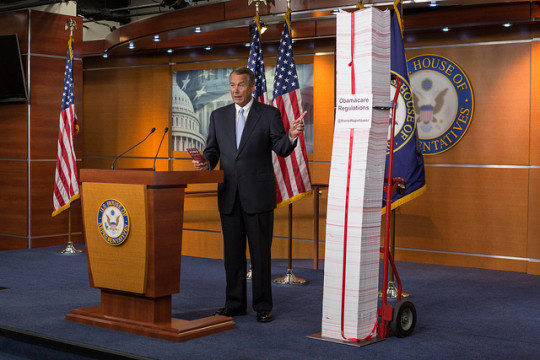
by: Jamie Inferrera, Staff Writer
Picture nearly 20,000 pieces of copy paper stacked neatly on top of one another. Over seven feet of paper secured on a dolly complete with a red ribbon bow. It stands taller than Shaquille O’Neal and it’s quickly creeping up the height of Yao Ming. What is this paper monster on wheels? It’s the “red tape tower.”
The paper tower travels around the Washington, D.C. area, mainly through the halls of the U.S. Capitol. It’s surely a conversation piece and it’s frequently spotted in photos on various social media outlets. Actually, it has its own Twitter handle: @theredtapetower.
The red tape tower represents all of the regulations associated with the Affordable Care Act. Even before the major policy changes of the Affordable Care Act began to take effect, the bureaucratic regulators were hard at work. Staring at a photo of nearly 20,000 pieces of paper, it is difficult to believe that this landmark policy change is not supposed to cost taxpayers any money.
There are regulations at every level of government. Focusing solely on the federal level, legislation passed by Congress oftentimes gives agencies or departments the authority to promulgate regulations to fully implement the legislative policy. The regulations are created through a bureaucratic process referred to as “rulemaking,” which is primarily overseen by the Administrative Procedure Act.
The average taxpayer is given an opportunity to provide input on proposed regulations through the Federal Register’s website. The Federal Register is the clearinghouse for all proposed and final regulations. A hard copy of the Federal Register is published annually. The first Federal Register, which was published in 1936, was a mere 2,260 pages.
While the number of pages in the Federal Register has been holding steady over the past decade (in the 70,000 to 80,000 page range), it is the cost of implementing the regulations that ultimately burdens taxpayers. As an example, have you ever wondered why you’re starting to see calorie counts pop up on menus? Buried deep within the Affordable Care Act legislation is a provision that requires all companies with 20 or more restaurants or vending machines to disclose the caloric count of each item.
The U.S. Food and Drug Administration estimates that completing the arduous task of calorie counting every food item will take the food service industry about 14 million additional hours of work each year. The National Automatic Merchandising Association also estimated that the cost of implementation can range anywhere from $3 to $100 per machine.
In 2010, the U.S. Small Business Administration estimated that the total annual cost of federal regulation was $1.75 trillion. Unfortunately, small businesses tend to suffer the worst from the excessive regulatory burden. The small, family-owned company with only 20 vending machines is still responsible for complying with the regulatory burden of calorie counting.
The Competitive Enterprise Institute, which has published a yearly report for the past 20 years on the regulatory burden, estimates that regulatory costs amount to $14,678 per family. On average, the federal government promulgates around 3,500 regulations a year, equating to nine regulations per day.
Whether taxpayers realize it or not, Americans are burdened by excessive regulations on a daily basis. Companies are increasingly employing or contracting attorneys to monitor the ever-changing regulatory climate, to interpret and ensure compliance with every nook and cranny. To learn more about the cost of red tape (as well as yellow and green tape too), take five minutes to watch the House floor speech that earned Pennsylvania Congressman Mike Kelly a standing ovation (http://youtu.be/F1YQDjpuY_U).